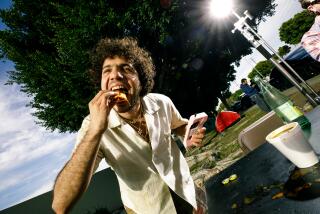The Versatile Side Dish That’s Giving Fries Some Competition
Food manufacturers have the power to exert enormous influence over the kinds of things Americans eat--far more than any real or perceived power of health professionals or lowly columnists.
We can tell you all day that something is probably not a good addition to a healthy diet or is a useless supplement, but let the advertising industry get hold of it and most people will quickly be convinced that whatever the ads say is true. And of course sometimes it is.
Couscous is something that most Americans had not even heard of a few years ago, and now we see ads on television touting it as a substitute for French fries and coining a new term, “couscous potato.” It seems unlikely that this strange North African form of pasta would ever replace the potato, but never underestimate the power of advertising.
Couscous is made from semolina wheat that has been precooked and then dried. Semolina flour is milled from durum wheat and is granular in appearance and texture. Like white flour, it has had the bran and germ removed during processing, so lacks many of the nutrients found in whole wheat. Semolina produces a dough that is high in gluten, and this makes it resilient enough for the pasta-making process.
Unlike Western and Asian pastas, couscous looks more like rice or grits than it does noodles. It is also not enriched, so it lacks some of the B vitamins found in other types of pasta.
And it cooks differently. Instead of adding a small amount of pasta to a large amount of water that is then drained away, couscous cooks more like rice and absorbs the cooking liquid. Quick-cooking (or instant) couscous, which is what we are most familiar with, can be ready in five minutes. The original form is labor intensive and requires two 30-minute steamings after an initial plumping time.
Couscous is essentially a neutral side dish, although the instant variety is also easy to serve as a hot cereal. It has little taste of its own but will pick up the flavor of the cooking liquid and anything that you place on top of it, like stews, vegetables or fruits. In Morocco, where couscous is a staple food, it is often served with hot sauces. It also lends itself to savory spices, such as cinnamon, turmeric, ginger and allspice.
A cup of cooked couscous has about 175 calories, is essentially fat free and contains 6 grams of protein, 36.5 grams of carbohydrate and a sprinkling of vitamins and minerals.
The packaged couscous mixes are convenient and come in many flavors. Just be sure to check the sodium content if you’re trying to control that in your diet. By using couscous with other ingredients that are nutrient dense, it can be an interesting menu item.
Here’s a recipe for Toasted Couscous Pumpkin Risotto (from “The Simply Healthy Lowfat Cookbook” [Rebus, 1995]), which brings together some flavors from a number of cuisines and provides a respectable array of nutrients (especially beta carotene) in a very low-fat dish.
TOASTED COUSCOUS PUMPKIN RISOTTO
Pepper puree:
1 garlic clove peeled
1 cup bottled roasted red peppers, rinsed and drained
Risotto:
1 1/2 cups couscous
1 large onion, minced
3 garlic cloves, minced
1 teaspoon sugar
1 1/2 cups canned low-fat chicken broth diluted with 2 cups water
1/2 cup sherry
3/4 cup canned solid-pack pumpkin
2 tablespoons grated Parmesan cheese
1/4 teaspoon freshly ground black pepper
1 1/2 teaspoons unsalted butter
*
Make the pepper puree. In a small saucepan of boiling water, blanch the garlic for 2 minutes. Transfer to a food processor; add the roasted peppers and process to a smooth puree. Set aside.
Make the risotto. In a large skillet, heat the couscous over medium heat, stirring frequently, until golden, about 3 minutes. Remove the skillet from the heat.
In a large saucepan, combine the onion, garlic and sugar with a half cup of diluted broth. Cook over medium heat, stirring frequently until the onion is wilted, about 7 minutes. Stir in the couscous and sherry and cook until the sherry has evaporated, about 1 minute.
Gradually add the remaining diluted broth to the saucepan, one-half cup at a time, allowing the couscous to absorb all the liquid before adding any more. Continue cooking and adding liquid until all the liquid has been added and the couscous is creamy. Stir in the pumpkin, Parmesan and black pepper and cook until heated through (about 3 minutes). Stir in the butter and serve topped with the pepper puree.
Makes 4 servings, each of which has 364 calories, 3.4 grams of fat, 5.9 milligrams of cholesterol, 396 milligrams of sodium, 6.8 milligrams of beta carotene, 47 milligrams of vitamin C, 89 milligrams of calcium, and 1.8 grams of dietary fiber.
*
Dr. Sheldon Margen is a professor of public health at UC Berkeley; Dale A. Ogar is managing editor of the UC Berkeley Wellness Letter. Send questions to Dale Ogar, School of Public Health, UC Berkeley, Berkeley CA 94720-7360, or by e-mail to daogar@uclink4.berkeley.edu. Eating Smart runs every Monday.
More to Read
Eat your way across L.A.
Get our weekly Tasting Notes newsletter for reviews, news and more.
You may occasionally receive promotional content from the Los Angeles Times.









